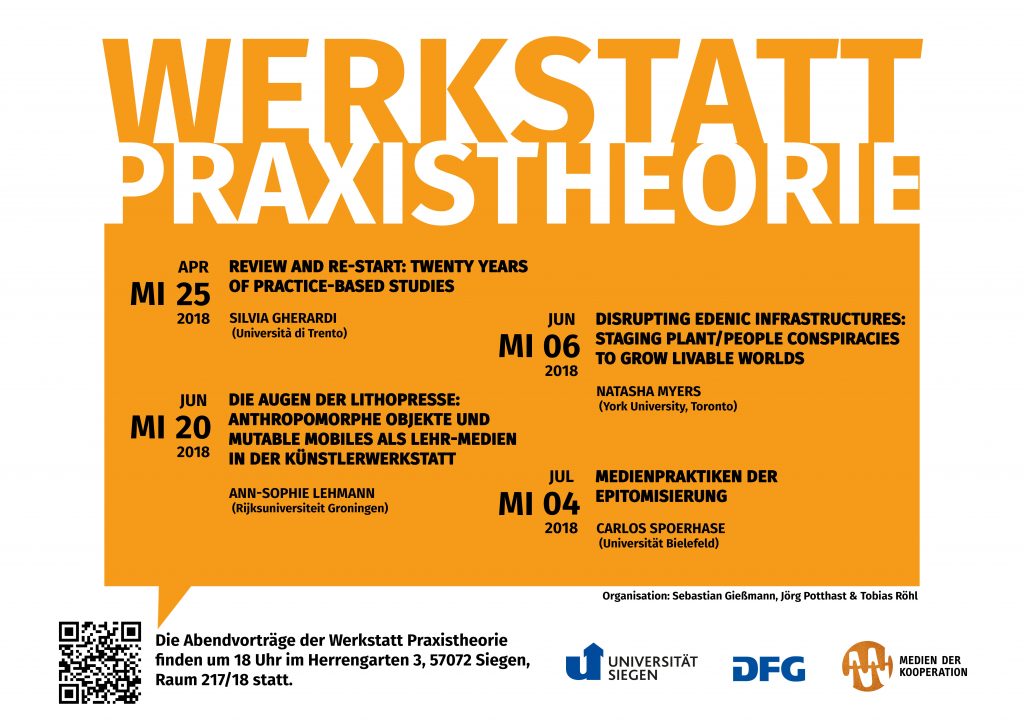Workshop Practice Theory Summer 2018
This semester the workshop practice theory will focus on media practices of delegation and experimentation.
The lecture and workshop series on Practice Theory aims to develop a new perspective on media history and media analysis. It is giving primacy to “practice” while focussing on processes of media production and work. We set out exploring media practices related to “coordination”, “delegation”, “registration & identification”,both with regard to a sound empirical foundation and to theoretical reflection. These categories are used to investigate media practices that specifically interconnect publics and infrastructures. Our lecture and workshop series on Practice Theory is dedicated to “Theoretical Empiricism” and will assemble international research that addresses questions of theory and empirical research symmetrically. For this purpose, three further categories are brought into play as part of the practice turn, namely repair work, experimentation, and actualization.

Talks in the Summer Term 2018:
Wednesdays at 18:00
Campus Herrengarten, Room AH-217/18
Around the 2000s there has been a ‘re-turn’ to practice theory, and the number of special issues of main journals in different disciplines testify its promise of a deep renovation in social sciences, after what has been called the ‘practice turn’ or the turn to practice. After twenty years we can track the effects of such a promise, keeping in mind that there is no such thing as a unified ‘practice theory’, only a body of highly diverse writings by thinkers who adopt a loosely defined ‘practice approach’.
The lecture and workshop propose to explore ‘practice-based studies’ as an umbrella concept and to retrace the way in which, over the years, I have developed a post-humanistic approach to social practice on the basis of an Actor-Network sensibility and the way in which the concept of practice appeared in the literature on learning and knowing in organizations. From this background, I illustrate an epistemology of practice grounded on relationality, multiplicity, and transformation, and I approach practice as an empirical phenomenon from the perspective of knowing as an activity situated in working and organizing practices. From this point of view the central interest in practice theories is how to bring forward a methodological framework to investigate the social, material, discursive, bodily, affective, aesthetic and ethical dimensions of practices.
Literature:
Practices and knowledges (2018 forthcoming)
Gherardi S, Rodeschini G. (2016), Caring as a collective knowledgeable doing: about concern and being concerned, Management Learning, 47(3): 266-284.
Corradi, G., Gherardi, S., Verzelloni, L. (2010) Through the Practice Lens: Where Is the Bandwagon of Practice-Based Studies Heading? Management Learning, 41(3): 265-283.
In response to ongoing ecological catastrophes, artists, landscape architects, and conservationists are designing gardens with the hopes of restaging people’s relationships with plants. This talk juxtaposes the aesthetics and politics of divergent garden infrastructures. One response to the widespread acknowledgement of human impact on the planet is Gardens By the Bay, Singapore’s gleaming, billion-dollar infrastructure for what could best be called “end-of-times” botanical tourism. Another response is a series of works produced by Viennese artist Lois Weinberger. His “counter gardens” – plant-based durational installations and performances – challenge the moral order of Edenic gardens by inciting the subversive forces of weedy plants, and by celebrating waste, decomposition, and decay. Weinberger’s artworks, which invert and disrupt assumptions about the function of garden enclosures enact what Rancière might call a “redistribution of the sensible.” In so doing they offer a mode of critique for grappling with Singapore’s spectacle, showing how those gardens reproduce the very logics, discourses and practices that gave rise to the devastation they purport to denounce.
Die Vermittlung von technischen und künstlerischen Verfahren und den ihnen innewohnendem Material- und Praxiswissen ist bekanntlich schwierig. Statische Bilder und Texte können darin immer nur eine ergänzende Funktion haben, da sie die Gleichzeitigkeit der Interaktion von Hand, Material, Werkzeug und herzustellendem Objekt nur unzureichend beschreiben, während Film zwar jene Komplexität erfassen kann, aber Herstellungsprozesse häufig idealisiert, ästhetisiert oder ‘depräsentiert’, in dem das, was langweilig, wiederholend oder fehlerhaft ist, nicht oder ausschließlich gezeigt wird.
In der Praxis muss Materialwissen darum immer wieder neu produziert, erlebt und gelernt werden. Dort wo Materialwissen gelernt werden kann, in Werkstätten, entstehen zu diesem Zweck immer wieder hybride mediale Formate, dies es Experten erlauben, ihr Wissen zu zeigen und zu vermitteln. Diese Medien scheinen sich jeglicher Standardisierung zu entziehen und widersprechen so scheinbar einer Basisdefinition des Medialen. Sie entstehen aus konkreten räumlichen und materiellen Bedingungen und sind ephemer und spontan, jedoch trotzdem geordnet und reproduzierbar, es sind mutable mobiles. Zu diesen Medien der Vermittlung gehören Materialproben, Verfahrensskizzen, Anordnungen von Objekten, Handlungen mit Materialien, die immer im Rahmen einer Kooperation zwischen Lehrer und Lehrenden entstehen, benutzt, aufgeräumt, weggeworfen werden um in der nächsten Lehrstunde oder Lektion wieder neu zu entstehen.
In Interviews sowie der Beobachtung und Teilnahme an Vermittlungssituationen mit den Werkstattleitern Fotografie, Gips & Ton, Lithographie und Farbe der Kunstakademie Minerva, Groningen, werden diese Medien sichtbar und zeigen ihre Affinität zum boundary objects, wie Sebastian Gießmann und Nadine Taha es beschreiben:
„Das Grenzobjekt sitzt als Medium tatsächlich »in der Mitte« und versammelt ein Kollektiv von Akteuren bzw. eine Praxisgemeinschaft um sich, oder bringt sie teils erst hervor. Für die Beteiligten definiert es eine Situation. Es ist auf diese Art und Weise ein Medium. Im konkreten Gebrauch ist es ein Mediator, dessen Vermittlungsfunktion eher »in Aktion« praktisch hervorgebracht wird als dass sie sozial, technisch, ökonomisch oder ästhetisch präfiguriert ware“ (Grenzobjekte & Medienforschung, 2017, S. 34).
Der zweite Teil des Vortrages versucht eine historische Einordnung solcher ephemeren Vermittlungsmedien, die durch Standardisierung (etwa Lehrmittelkästen, Materialarchive, Object Lessons) immer wieder ihre eigene Aufhebung betrieben haben, da ihre notwendige Vergänglichkeit, Verschiedenartigkeit und Prozesshaftigkeit sich dem Prinzip Archivierung und Wiederverwendung zu wiedersetzen scheint.
Die Beobachtung von Kultur ist auch in der Gegenwart auf Medienpraktiken der Epitomisierung angewiesen. Der Vortrag wird sich darum bemühen, diese Medienpraktiken anhand von aktuellen Beispielen vorzustellen und in eine übergreifende Theorie der Epitomisierung zu intergrieren.
Contact:
Dr. Sebastian Gießmann
sebastian.giessmann[æt]uni-siegen.de